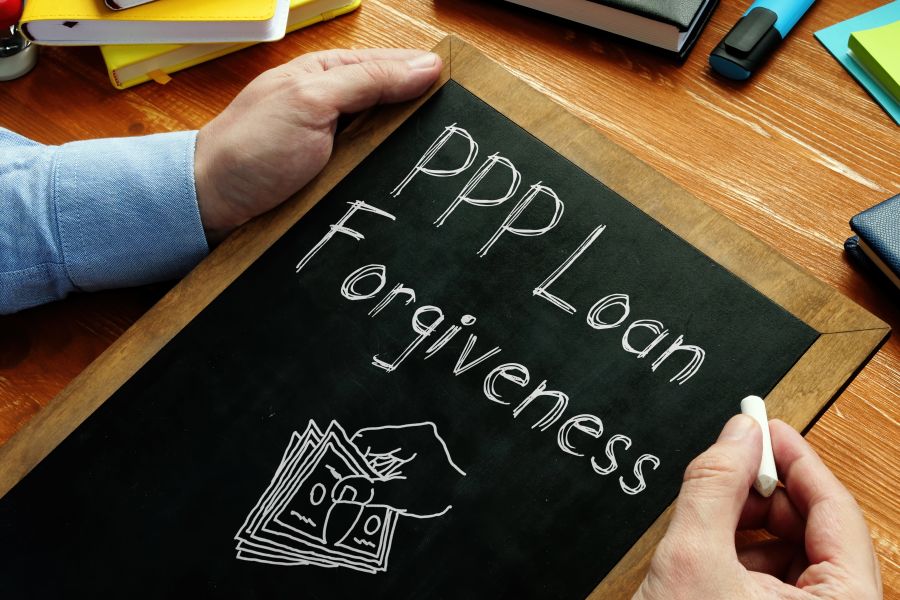New FAQs Address PPP Loan Forgiveness Issues

The U.S. Small Business Administration (SBA), in consultation with the Department of the Treasury, released guidance on 8/4/2020 answering 23 frequently asked questions (FAQs) regarding the forgiveness of Paycheck Protection Program (PPP) loans.
The PPP Loan Forgiveness FAQs, published in a new 10-page document, are divided into the following four sections addressing different aspects of the process and on calculations PPP borrowers should use to determine how much of their loan is forgivable.
- General Loan Forgiveness FAQs
- Loan Forgiveness Payroll Costs FAQs
- Loan Forgiveness Non-Payroll Costs FAQs
- Loan Forgiveness Reductions FAQs
Borrowers and lenders may rely on the guidance provided in this document as SBA’s interpretation, in consultation with the Department of the Treasury, of the CARES Act, the Flexibility Act, and the Paycheck Protection Program Interim Final Rules (“PPP Interim Final Rules”).
Following are the 23 FAQs which are answered in the SBA’s PPP FAQs on PPP Loan Forgiveness document:
General Loan Forgiveness FAQs
(Q1) Which loan forgiveness application should sole proprietors, independent contractors, or self-employed individuals with no employees complete?
(Q2) Can PPP lenders use scanned copies of documents, E-signatures, or E-consents for loan forgiveness applications and loan forgiveness documentation?
(Q3) If a borrower submits a timely loan forgiveness application, does the borrower have to make any payments on its loan prior to SBA remitting the forgiveness amount, if any?
Loan Forgiveness Payroll Costs FAQs
(Q1) Are payroll costs that were incurred during the Covered Period 1 or the Alternative Payroll Covered Period 2 but paid after the Covered Period or the Alternative Payroll Covered Period eligible for loan forgiveness?
(Q2) Are payroll costs that were incurred before the Covered Period but paid during the Covered Period eligible for loan forgiveness?
(Q3) Are borrowers required to calculate payroll costs for partial pay periods?
(Q4) For purposes of calculating cash compensation, should borrowers use the gross amount before deductions for taxes, employee benefits payments, and similar payments, or the net amount paid to employees?
(Q5) Are only salaries or wages covered by loan forgiveness, or can a borrower pay lost tips, lost commissions, bonuses, or other forms of incentive pay and have such costs qualify for loan forgiveness?
(Q6) What expenses for group health care benefits will be considered payroll costs that are eligible for loan forgiveness?
(Q7) What contributions for retirement benefits will be considered payroll costs that are eligible for loan forgiveness?
(Q8) How is the amount of owner compensation that is eligible for loan forgiveness determined?
Loan Forgiveness Non-Payroll Costs FAQs
(Q1) Are nonpayroll costs incurred prior to the Covered Period, but paid during the Covered Period, eligible for loan forgiveness?
(Q2) Are nonpayroll costs incurred during the Covered Period, but paid after the Covered Period, eligible for loan forgiveness?
(Q3) If a borrower elects to use the Alternative Payroll Covered Period for payroll costs, does the Alternative Payroll Covered Period apply to nonpayroll costs?
(Q4) Is interest on unsecured credit eligible for loan forgiveness?
(Q5) Are payments made on recently renewed leases or interest payments on refinanced mortgage loans eligible for loan forgiveness if the original lease or mortgage existed prior to February 15, 2020?
(Q6) Covered utility payments, which are eligible for forgiveness, include a “payment for a service for the distribution of . . . transportation” under the CARES Act. What expenses does this category include?
(Q7) Are electricity supply charges eligible for loan forgiveness if they are charged separately from electricity distribution charges?
Loan Forgiveness Reductions FAQs
(Q1) Will a borrower be subject to a reduction to its forgiveness amount due to a reduction in FTE employees during the Covered Period if the borrower offered to rehire one or more laid off employees but the employees declined?
(Q2) If a seasonal employer elects to use a 12-week period between May 1, 2019 and September 15, 2019 to calculate its maximum PPP loan amount, what period in 2019 should be used as the reference period for calculating any reductions in the loan forgiveness amount?
(Q3) When calculating the FTE Reduction Exceptions in Table 1 of the PPP Schedule A Worksheet on the Loan Forgiveness Application (SBA Form 3508 or lender equivalent), do borrowers include employees who made more than $100,000 in 2019 (those listed in Table 2 of the PPP Schedule A Worksheet)?
(Q4) How do borrowers calculate the reduction in their loan forgiveness amount arising from reductions in employee salary or hourly wage?
(Q5) For purposes of calculating the loan forgiveness reduction required for salary/hourly wage reductions in excess of 25% for certain employees, are all forms of compensation included or only salaries and wages?
Answers to these 23 FAQs, inclusive of illustrative examples as applicable, can be found here:
SBA’s PPP FAQs on PPP Loan Forgiveness
(This is Blog Post #869)


